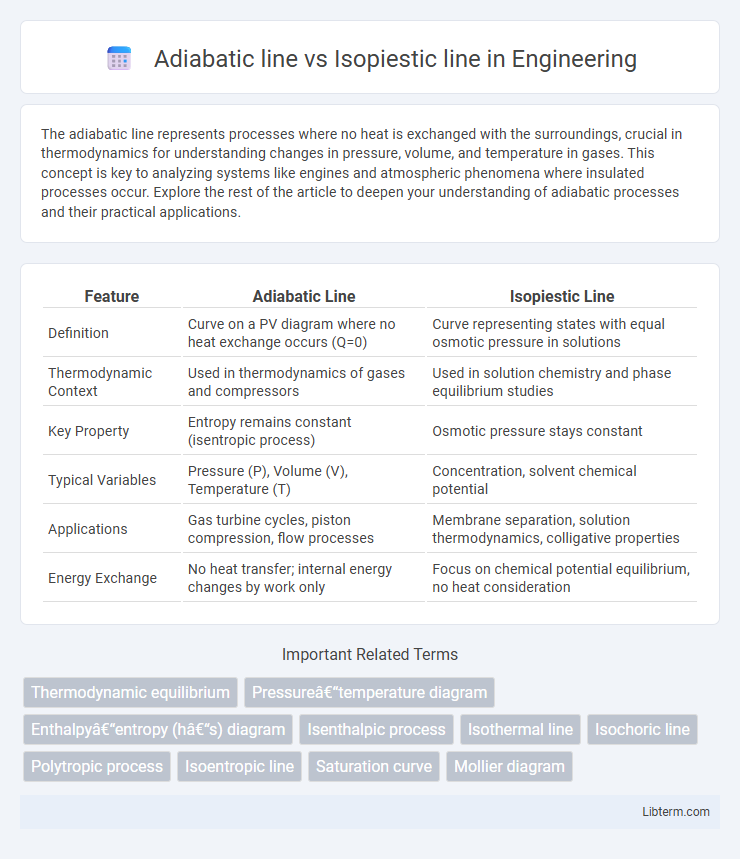The adiabatic line represents processes where no heat is exchanged with the surroundings, crucial in thermodynamics for understanding changes in pressure, volume, and temperature in gases. This concept is key to analyzing systems like engines and atmospheric phenomena where insulated processes occur. Explore the rest of the article to deepen your understanding of adiabatic processes and their practical applications.
Table of Comparison
| Feature | Adiabatic Line | Isopiestic Line |
|---|---|---|
| Definition | Curve on a PV diagram where no heat exchange occurs (Q=0) | Curve representing states with equal osmotic pressure in solutions |
| Thermodynamic Context | Used in thermodynamics of gases and compressors | Used in solution chemistry and phase equilibrium studies |
| Key Property | Entropy remains constant (isentropic process) | Osmotic pressure stays constant |
| Typical Variables | Pressure (P), Volume (V), Temperature (T) | Concentration, solvent chemical potential |
| Applications | Gas turbine cycles, piston compression, flow processes | Membrane separation, solution thermodynamics, colligative properties |
| Energy Exchange | No heat transfer; internal energy changes by work only | Focus on chemical potential equilibrium, no heat consideration |
Introduction to Thermodynamic Lines
Adiabatic lines represent processes with no heat exchange, where entropy remains constant, and are crucial in understanding energy transformations in thermodynamic systems. Isopiestic lines denote states of equal vapor pressure, important for analyzing phase equilibria in multicomponent mixtures. Both lines serve as fundamental tools in mapping thermodynamic properties and guiding process design in chemical engineering.
Understanding the Adiabatic Line
The adiabatic line represents a process in which no heat is exchanged with the surroundings, resulting in changes in pressure and temperature that follow specific thermodynamic paths. Understanding the adiabatic line is crucial for analyzing processes such as compression and expansion in engines or atmospheric phenomena, as it reflects how temperature and pressure evolve without heat transfer. In contrast, the isopiestic line involves constant vapor pressure conditions, emphasizing equilibrium between phases rather than thermal insulation.
Defining the Isopiestic Line
The isopiestic line represents a curve on a phase diagram where two or more solutions maintain constant vapor pressure, allowing direct comparison of activities or chemical potentials without phase change interference. Unlike the adiabatic line, which follows constant entropy conditions during thermodynamic processes, the isopiestic line holds the vapor pressure equal across different compositions or temperatures. This property enables precise determination of activity coefficients in multi-component systems by ensuring equilibrium vapor pressures during experimental measurements.
Key Differences Between Adiabatic and Isopiestic Lines
Adiabatic lines represent processes with no heat exchange between the system and its surroundings, characterized by changes in pressure and temperature without altering entropy. Isopiestic lines, on the other hand, maintain constant vapor pressure, reflecting equilibrium between phases at different compositions or temperatures. The key difference lies in adiabatic lines involving thermodynamic transformations under insulated conditions, while isopiestic lines depict phase equilibrium at constant pressure conditions.
Mathematical Representation of Adiabatic Line
The adiabatic line in thermodynamics is mathematically represented by the relation \( PV^\gamma = \text{constant} \), where \( P \) is pressure, \( V \) is volume, and \( \gamma \) is the adiabatic index or heat capacity ratio. This equation models processes with no heat exchange, distinguishing it from the isopiestic line, which characterizes states with constant vapor pressure in multicomponent systems. The isopiestic condition is typically expressed by equal chemical potentials, but the adiabatic line's power-law form is central to analyzing reversible adiabatic expansions or compressions in ideal gases.
Mathematical Representation of Isopiestic Line
The isopiestic line represents the set of points where the vapor pressure of a solution remains constant, mathematically expressed as the locus satisfying the equation m_solvent^1 = m_solvent^2, where m denotes the chemical potential of the solvent in two different solutions. This line can be derived from the equality of solvent activities, a_solv^1 = a_solv^2, leading to the relationship involving solute concentrations that maintain constant solvent vapor pressure. Unlike the adiabatic line, which describes temperature and entropy changes with no heat exchange, the isopiestic line is specifically used to analyze equilibrium states in binary mixtures under constant vapor pressure conditions.
Physical Significance in Thermodynamics
The adiabatic line in thermodynamics represents a process where no heat exchange occurs with the surroundings, indicating constant entropy and primarily reflecting energy transformations within an isolated system. In contrast, the isopiestic line denotes conditions of equal vapor pressure between two phases, emphasizing equilibrium and phase coexistence rather than energy conservation. Understanding these lines facilitates analysis of thermodynamic paths, with the adiabatic line crucial for studying insulated system behavior and the isopiestic line essential in phase equilibrium and solution chemistry contexts.
Real-World Applications of Adiabatic and Isopiestic Lines
Adiabatic lines, representing processes with no heat exchange, are crucial in meteorology for predicting atmospheric temperature changes during air parcel displacement, aiding weather forecasting and climate modeling. Isopiestic lines, indicating constant vapor pressure, have significant applications in chemical engineering for controlling solvent evaporation rates and designing distillation columns. Both concepts optimize industrial processes by improving energy efficiency and material separation accuracy in real-world systems.
Graphical Comparison: Adiabatic vs Isopiestic Lines
Adiabatic lines represent paths of no heat exchange, showing temperature and pressure changes during processes without heat transfer, typically curving steeply on thermodynamic charts. Isopiestic lines depict constant vapor pressure conditions, appearing flatter and indicating equilibrium states with unchanged moisture content or vapor pressure. Graphically, adiabatic lines sharply vary with pressure and temperature, whereas isopiestic lines maintain near-constant pressure, highlighting fundamental differences in thermodynamic process behavior.
Summary: Choosing the Right Thermodynamic Path
The adiabatic line represents processes with no heat exchange, crucial for analyzing rapid compressions or expansions in thermodynamic systems, while the isopiestic line maintains constant vapor pressure, vital for studies involving phase equilibria and moisture content. Selecting the right thermodynamic path depends on the system's constraints, where adiabatic conditions suit closed, insulated systems and isopiestic conditions apply to open or equilibrium scenarios. Understanding these distinct paths ensures accurate modeling of energy transfer and phase behavior in practical applications.
Adiabatic line Infographic

 libterm.com
libterm.com